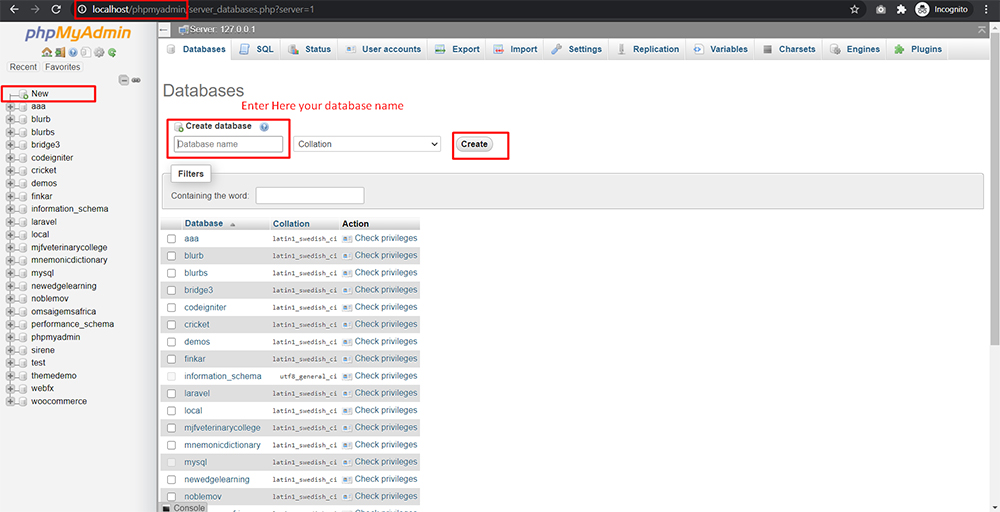

- #Godaddy phpmyadmin localhost how to
- #Godaddy phpmyadmin localhost full
- #Godaddy phpmyadmin localhost windows 10
- #Godaddy phpmyadmin localhost password

so now I am stuck and i have no idea what to do as I tried all the ways. I have contacted Godaddy support but they told me this out of their scope.
#Godaddy phpmyadmin localhost full
There is no way to logout and login to phpMyAdmin from the interface, so I tried to download the last version of phpMyAdmin and uploaded to site root directory then o navigate to it and logged in with the user that have full privileges and when I started to import the database it throw the same error. "the user I have created have full privileges". I am accessing phpMyAdmin from cPanel but before that I have created the database test_db created user associated with it so when I navigate to phpMyAdmin it show me that i am logged in with the user which the same user used for cPanel login and it doesn't show the user that I have created. mainly provides Linux, Ubuntu, CentOS, Network. How can I restore the backup from the GoDaddy hosted site to Local WP? Can I just create a new site with whatever name I pick, or must it be the same as the site name in the GoDaddy hosted site? (I tried naming the site the same as the site name at GoDaddy, but it did not help.I have purchase i hosting with cpanel in godaddy and I am migrating a WordPress site, but the problem when I am trying to import database it gave me this error #1044 - Access denied for user to database 'test_db' is created to provide wise and useful solutions for different IT related issues, problems, etc.
#Godaddy phpmyadmin localhost password
I changed the database username and password in the wp-config.php file to the defaults created with the new Local site. On starting the site, it gets error 1045. The database tab then shows the Host, Port, and Database name correctly. I edited the app\public\wp-config.php file to change the DB_NAME to the name in the backed up wp-config.php file and DB_HOST to ‘localhost.

I deleted the files in app\public and copied the files from the file backup to that directory. sql file from the backup to the app\sql directory (maybe that is not a way to get the database restored).
#Godaddy phpmyadmin localhost how to
I am not finding how to get to phpMyAdmin or command line MySQL to restore the database backup. When a user pings localhost, the request remains on the local network and connects to the machine in use. (I used the oldest version of MySQL hoping it will be compatible with the existing backup.) I also tried MySQL 8.0.16 and got the same result. Localhost is a loopback address used for testing and developing on a local machine. I created a site in Local WP with PHP 7.4.30, Apache 2.4.43, and MySQL 5.7.28. The Import starts, copies a lot of files, and then just stops. I tried creating a new Local WP site using the option to import an existing ZIP file, but the GoDaddy backup probably is not compatible with a WP Migrate backup. (I did not find the version of Apache or MySQL that GoDaddy is using.) Replication (Upgrading PHP to version 8.0 breaks the theme that I am using, so I am sticking with 7.4). The hosting used PHP 7.4, Apache, MySQL, and WordPress 6.1.1.
#Godaddy phpmyadmin localhost windows 10
I am running Local 6.6.1+6281 on Windows 10 Pro 21H2. If you have screenshots that can help clarify what is happening, please include them! System Details Replicationĭescribe the steps that others can take to replicate this issue. I am able to create a new, plain WordPress site in Local and access it in a Browser. I have downloaded those two backup files and would like to import/restore them in Local WP. php - Connect to GoDaddy server database from localhost computer - Stack Overflow I programmed a website in PHP that uses a MySQL Server through GoDaddy. GoDaddy does scheduled backups of the site files and database. Be sure to take note of the database user assigned to it in cPanel > MySQL.

I need to import a site from a GoDaddy Managed WordPress site. The latest version of phpMyAdmin allows you to change the name of the database.


 0 kommentar(er)
0 kommentar(er)
